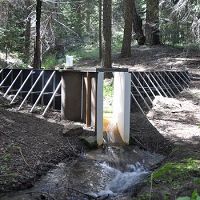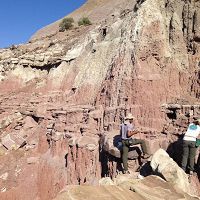MODELS
The IML-CZO uses several conceptual and numerical models to investigate coupled earth surface processes. Our dual event-and-continuum conceptual framework lends itself to novel modeling approaches based on the identification of activity centers and tracking of their connectivity by analyzing emerging patterns of key state variables across scales with multiplicity of types of changes – changes in mean, variance, extremes/outliers, trends, and steps. This will include modeling of:
- Soil structure formation (Theme A)
- Microbial and nutrient dynamics (Theme B)
- Surface and groundwater interactions (Theme C)
- Landscape evolution (Theme A & D)
The analysis of observational data and modeling results, which will be derived from the network of sites in this IML-CZO, will be used to study the feedbacks of different processes, capture responses to change, and perform upscaling. Finally, we will develop typologies based on similarity approaches for extrapolating our results to larger scales in the Midwest and similar low-gradient IMLs worldwide.
Conceptual model of an experimental farm with mobile sensor platform to support experiments at the activity centers.
The IML-CZO is using an integrated modeling approach that provides a framework for integrating high-resolution data (e.g., LiDAR, hyperspectral imagery) and event-driven dynamics, shaping and shaped by long-term dynamics, to provide a broader scale prediction and assessment framework. This effort will build upon the extensive modeling experience in our team and also draw upon other available models in collaboration with other CZOs. By necessity, this effort requires multi-model exploration for process level understanding, systematically leading to theories that result in developing a integrated model of IMLs. We envision our modeling to not simply be a programming exercise but an instrument to iteratively create, test, and refine mathematical theories of components, as well as coupled dynamics, and to resolve competing scientific notions that lead to better understanding and prediction. Table 1 provides a possible list of models from which an intellectual foundation can be drawn to explore knowledge gaps and formulate a more complete theory of CZ dynamics.
Existing Models/Modules Available as Starting Points for Proposed IML-CZO Modeling
- Bioturbation
- Soil structure formation
- Microbial and nutrient dynamics
- Vegetation-soil water interaction
- Spatial hydrology
- Surface- and groundwater interaction
- Landscape evolution
- Stochastic weather generator
Modelling News

FEATURED
CZ colleagues: Please contact us about proposals for NSF’s CZ Collaborative Network, due 02 Dec 2019
08 Jul 2019 - CZO will end Nov 2020, succeeded by the “CZ Collaborative Network”. Let’s explore how the CZ community can build upon the CZOs via new NSF proposals.

Water Resources Research Special Collection: Concentration-discharge relations in the critical zone
30 Oct 2017 - Water Resources Research published a new special collection in September 2017 featuring concentration-discharge research from multiple CZOs.

EOS: Taking the Pulse of the Earth’s Surface Systems
04 Dec 2015 - Taking the Pulse of the Earth's Surface Systems In September of 2014, Laurel Larsen (UC Berkley), Elizabeth Hajek (Penn State), and others...

Using a CZO network to explore the architecture, dynamics and evolution of the Critical Zone
03 Nov 2014 - The US CZO National Office has organized a webinar on December 8, 2014 at 11AM - 12:30 PM ET.

Reactive Transport Modeling Survey – Community Needs for Biogeochemical Studies
08 Apr 2014 - Reactive Transport Modeling Survey – Community Needs for Biogeochemical Studies The below survey is designed by Alexis Navarre-Sitchler, Kate...
Explore Further

